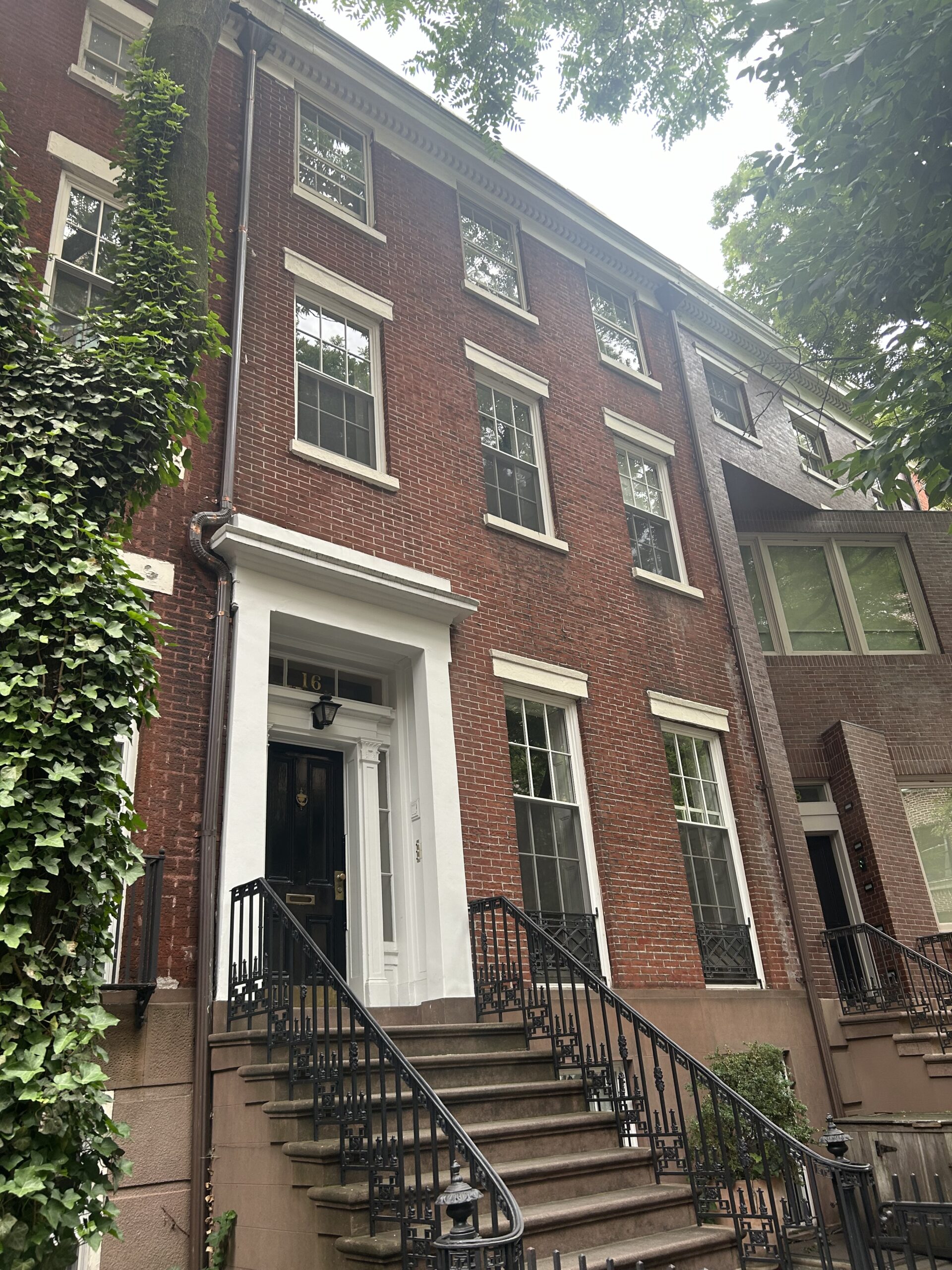In 1834, when Henry Brevoort Jr. moved into his grand mansion at the corner of Fifth Avenue and 9th Street, the New York City he encountered was on the brink of transformation. Set on what was once the Brevoort Farm, his home stood solitary on an unpaved Fifth Avenue, destined to become one of Manhattan’s most prestigious addresses. The Brevoort mansion quickly became more than just a home; it was a social epicenter that set the standard for the elegant residences soon to rise around it.
Henry and his wife, Laura Carson, were part of New York’s emerging elite, and their legacy extended to their eight children. By 1844, Brevoort began constructing seven identical Greek Revival-style homes on West 11th Street, between Fifth and Sixth Avenues, as gifts for his daughters. Completed in 1845, these homes—with their stately brownstone stoops, expansive parlor windows, and Corinthian-framed doorways—became symbols of the architectural elegance that defined the area during that era.
Among these homes, 16 West 11th Street initially housed the prosperous Joseph H. Coates family, whose wealth came from the Pearl Street firm of Miller & Coates, dealing in metals. The Coates family lived there until 1857, when it became a high-end boarding house under the care of Caroline Inman, a widow who carefully maintained the home’s exclusivity by limiting the number of boarders. The house returned to a single-family residence in 1864 under David L. Reed, a successful produce broker whose public image was marred by scandalous incidents reported in the press, including an explosion in 1881 that caused significant damage to the home.
By 1887, the house had passed into the hands of one of New York’s most prominent figures, Algernon Sydney Sullivan, and his wife, Mary Mildred Sullivan. Born in Indiana in 1826, Sullivan moved to New York after establishing a successful legal career in Cincinnati. In New York, his influence grew as he served as assistant district attorney and co-founded the prestigious law firm Sullivan & Cromwell in 1879. Sullivan’s legal prowess was matched by his commitment to public service, exemplified by his role as a founder of the New York Southern Society, which sought to preserve Southern traditions among expatriates in the North.
Mary Mildred Sullivan, originally from Winchester, Virginia, married Algernon in 1855 and became a central figure in New York’s social and philanthropic circles. Known for her leadership in organizing the annual Charity Ball—a cornerstone event in New York society that raised significant funds for various causes—Mary also served as president of the New York Nursery and Child’s Hospital for many years. Her dedication to service was unwavering, extending to numerous charitable initiatives throughout her life.
Tragically, Algernon Sydney Sullivan’s time in his West 11th Street home was short-lived. In late 1887, he fell ill and died on December 4, leaving behind a legacy of legal excellence and public service. Mary continued to live in the home, where she maintained her influential role in New York society until her death in 1933. Her contributions to charity and her leadership in various organizations left a lasting impact on the city.
The home at 16 West 11th Street later became a residence for artists Joe Hazan and Jane Freilicher, who purchased it in 1957. Freilicher, a painter associated with the New York School, and Hazan converted the house into three living spaces, one of which was rented to actor Dustin Hoffman during the early years of his career. Hoffman lived in the house during the filming of his breakthrough role in The Graduate and continued to reside there while filming Midnight Cowboy, cementing his status as one of Hollywood’s leading actors.
The house’s storied history took a tragic turn in 1970 when a deadly explosion at the neighboring property, 18 West 11th Street, rocked the neighborhood. Members of the radical Weatherman group were constructing a bomb in the basement when it detonated, destroying the building and causing significant damage to the surrounding homes, including the Hoffmans’ residence. Fortunately, Hoffman’s family and their babysitter escaped unharmed, but the incident left a lasting impact on the community.
Today, 16 West 11th Street remains a three-family residence, a testament to the lives and events it has witnessed over the years. As the Algernon Sydney Sullivan Foundation prepares to celebrate the centennial of the Sullivan Award on September 20, 2024, it is an opportune moment to reflect on the Sullivans’ deep roots in New York City. From Algernon’s founding of Sullivan & Cromwell to Mary’s tireless charity work, their legacy of service and commitment to helping others endures. This legacy continues through the work of the Sullivan Foundation and the ongoing influence of Sullivan & Cromwell, a firm that remains dedicated to the principles upon which it was founded. The upcoming centennial celebration will not only honor the past 100 years of the Sullivan Award but also inspire future generations to carry forward the Sullivans’ legacy of service, integrity, and dedication to making the world a better place.
______________________________________________________________________
This article draws upon information from an original post by Tom Miller, Daytonian in Manhattan, titled ‘The 1845 Joseph H. Coates House – 16 West 11th Street,’ which was published, March 2024. Additional content and revisions have been included.
Back to all News items.


